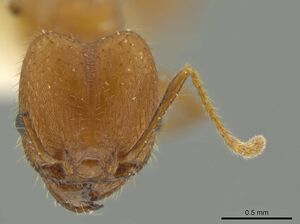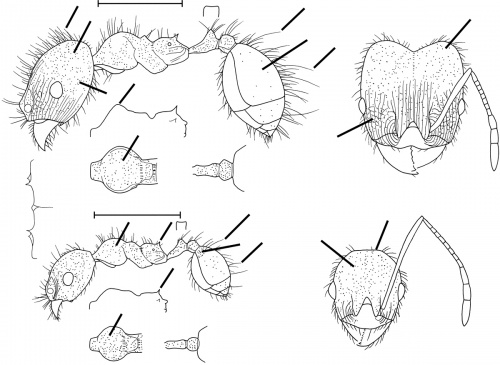Pheidole erethizon
| Pheidole erethizon | |
|---|---|

| |
| Scientific classification | |
| Kingdom: | Animalia |
| Phylum: | Arthropoda |
| Class: | Insecta |
| Order: | Hymenoptera |
| Family: | Formicidae |
| Subfamily: | Myrmicinae |
| Tribe: | Attini |
| Genus: | Pheidole |
| Species: | P. erethizon |
| Binomial name | |
| Pheidole erethizon Wilson, 2003 | |
Nothing is known about the biology of erethizon.
Identification
See the description in the nomenclature section.
Keys including this Species
Distribution
Recorded from the type locality (Michoacán); Azizintla, Guerrero; and Miacatlan, Morelos. (Wilson 2003)
Latitudinal Distribution Pattern
Latitudinal Range: 19.48783° to 18.75°.
| North Temperate |
North Subtropical |
Tropical | South Subtropical |
South Temperate |
- Source: AntMaps
Distribution based on Regional Taxon Lists
Neotropical Region: Mexico (type locality).
Distribution based on AntMaps
Distribution based on AntWeb specimens
Check data from AntWeb
Countries Occupied
| Number of countries occupied by this species based on AntWiki Regional Taxon Lists. In general, fewer countries occupied indicates a narrower range, while more countries indicates a more widespread species. |

|
Estimated Abundance
| Relative abundance based on number of AntMaps records per species (this species within the purple bar). Fewer records (to the left) indicates a less abundant/encountered species while more records (to the right) indicates more abundant/encountered species. |

|
Biology
Castes
Images from AntWeb
 
| |
| Paratype Pheidole erethizon. Worker (major/soldier). Specimen code jtlc000016369. Photographer Skyler Oswald, uploaded by University of Utah. | Owned by MCZC. |
Nomenclature
The following information is derived from Barry Bolton's Online Catalogue of the Ants of the World.
- erethizon. Pheidole erethizon Wilson, 2003: 154, figs. (s.w.) MEXICO.
Unless otherwise noted the text for the remainder of this section is reported from the publication that includes the original description.
Description
A member of the crassicornis group characterized in both the major and minor by exceptionally dense, long hair (reaching an extreme in the gastral pilosity of the major); and entire head (except frontal triangle and central piece of clypeus),mesosoma, and waist foveolate and opaque. In addition, the minor is unusual within the crassicornis group in possessing a narrowed occiput seen in full-face view, yet nevertheless lacking a nuchal collar.
MEASUREMENTS (mm) Holotype major: HW 1.26, HL 1.34, SL 0.92, EL 0.22, PW 0.64. Paratype minor: HW 0.58, HL 0.70, SL 0.86, EL 0.16, PW 0.42.
COLOR Major: concolorous medium yellow with a very slight reddish tinge.
Minor: concolorous medium yellow.
Figure. Upper: holotype, major. Lower: paratype, minor. Scale bars = 1 mm.
Type Material
MEXICO: San José Purua, Michoacán, col. A. B. Hamton. Museum of Comparative Zoology
Etymology
NL erethizon, porcupine, referring to the very long, bristly pilosity of the major and minor.
References
- Wilson, E. O. 2003. Pheidole in the New World: A dominant, hyperdiverse ant genus. Harvard University Press, Cambridge, MA. (page 154, fig . major, minor described)
- Varela-Hernández, F., Medel-Zosayas, B., Martínez-Luque, E.O., Jones, R.W., De la Mora, A. 2020. Biodiversity in central Mexico: Assessment of ants in a convergent region. Southwestern Entomologist 454: 673-686.
- Vazquez-Franco, C.M., Castano-Meneses, G., Rios-Casanova, L., Morrone, J.J. 2024. Three new species of Pheidole Westwood, 1839 (Hymenoptera: Formicidae: Myrmicinae: Attini) from central Mexico. Zootaxa 5523(2), 192–210 (doi:10.11646/zootaxa.5523.2.3).
- Vázquez-Franco, C.M., Morrone, J.J. 2022. The genus Pheidole (Hymenoptera: Formicidae: Myrmicinae) in Puebla, Mexico. Revista Mexicana de Biodiversidad 93: e933820 (doi:10.22201/ib.20078706e.2022.93.3820).
References based on Global Ant Biodiversity Informatics
- Vásquez-Bolaños M. 2011. Lista de especies de hormigas (Hymenoptera: Formicidae) para México. Dugesiana 18: 95-133
- Wilson, E.O. 2003. Pheidole in the New World: A Dominant, Hyperdiverse Genus. Harvard University Press


